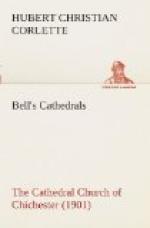The most beautiful monument now remaining in the church is that which is said to represent Maud, Countess of Arundel (1270) (5). The modelling of the whole figure and the long flowing lines of her robes are worthy of careful study. The whole pose and the disposition of the two angels at the head arranging the pillows, with the two dogs upon which her feet rest, have been finely conceived and well executed. The hands are clasped over the breast, with the forearms bent upwards slightly towards the face. On each of the long sides of the base supporting the figure are six elongated quatrefoil panels, containing in all six female figures and six shields. Between the quatrefoils are winged heads of ten angelic figures. The blazoning of the shields is entirely gone, and the brilliant colouring that once covered the entire monument is only to be traced in a few places. The outer robe still shows some signs of the rich blue with which it used to be covered. The face of the figure appears to be badly mutilated, but the damage to the features has been done principally by an endeavour to preserve them. A thick coat of plaster had been placed over the face to protect it from injury, perhaps in the seventeenth century or earlier, and this was never completely removed. It had become gradually polished like the material of the figure itself, and so it remains, with a cut across it to represent a mouth. The remains of the real face are still hidden beneath.
[Illustration: THE SACRISTY (SEE P. 90). S.B. Bolas & Co. photo.]
Close to this effigy, but in the aisle farther to the east, and on the north wall, are two admirable memorial tablets which were designed in the eighteenth century. One is in memory of Dean Hayley and his wife (6), and the other in memory of Henry Baker and his wife and their only child (7), who, by comparison with the other tablet, appears to have been a second wife of the same Thomas Hayley.
Close to the porch in the south aisle is the only complete old brass in the building (8). It is dated 1592, and records the fact that “Mr. William Bradbridge” was “thrice Maior of this Cittie,” and “had vi sonnes & viii daughters.” The other monuments in the nave are those of Matthew Quantock, Dean Cloos, Bishop Arundel, and William Huskisson, sometime member of Parliament for Chichester. One on the south side of the west porch is Bishop Stephen de Berghstead’s, and the other opposite on the north is a work of the fifteenth century.
The #Choir and Sanctuary#—These are very different in appearance now from what they were, as will be seen by reference to the chapter on the history of the fabric.
The #Reredos# was designed by Messrs. Slater & Carpenter, and has never been completed. It is generally considered that it is not at all in keeping with the character of the building, and there is some hope that it may be one day removed. The subject of the figure-work in the panel is “The Ascension.”




